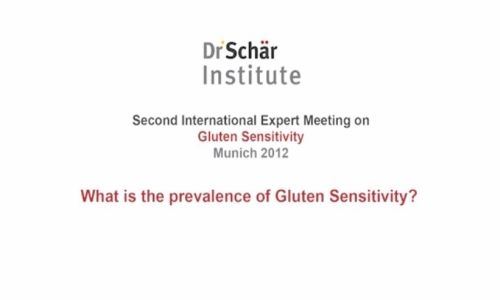Prévalence de la sensibilité au gluten non coeliaque inconnue à ce jour

Le nombre de personnes souffrant de sensibilité au gluten non coeliaque ne correspond qu’à des estimations qui se situent entre 1 et 6 % de la population, pourcentage supérieur à celui de la maladie cœliaque. Les chiffres réels sont vraisemblablement bien supérieurs pour ces deux affections.
La sensibilité au gluten non coeliaque est probablement plus fréquente que les affections liées au gluten telles que la maladie cœliaque et l’allergie au blé. Jusqu’à présent, nous ne disposons pas d’études épidémiologiques permettant de vérifier ces estimations.
Bilan de la conférence consensuelle sur les affections liées au gluten
Plus d'informations à ce sujet
Études
1
Montrer tout
Vidéo
1
Montrer tout

Systematic review: non coeliac gluten sensitivity
Background
Non coeliac gluten sensitivity (NCGS) is a controversial emerging disorder. Despite reported symptoms related to the ingestion of gluten, NCGS remains a diagnosis based on the exclusion of coeliac disease, given the absence of reliable biomarkers.
Aim
To evaluate the prevalence, diagnostic exclusion of coeliac disease and the efficacy of a gluten-free diet (GFD) for NCGS patients.
Methods
A PubMed search was performed up to December 2014. According to consensus diagnostic criteria, NCGS was defined as self-reported gluten intolerance, negative coeliac serology and absence of villous atrophy. Studies evaluating the impact of a GFD on patients with irritable bowel syndrome (IBS) were also included.
Results
Prevalence rates of NCGS (0.5–13%) differed widely. Seventeen studies, including 1561 patients (26 children), met the inclusion criteria for NCGS. HLA haplotypes could not be linked to histology [normal or lymphocytic enteritis (LE)] in 1123 NCGS patients. HLADQ2/DQ8 haplotypes were present in 44% of NCGS patients. After advanced diagnostic techniques in 189 NCGS patients combining LE and HLADQ2/DQ8 haplotypes, 39 (20%) were reclassified as coeliac disease. There was a higher than expected family history of coeliac disease and autoimmune disorders in NCGS patients. A GFD resulted in variable results for variable, but significantly improved stool frequency in HLADQ2 positive diarrhoea-predominant IBS patients.
Conclusions
Prevalence rates for NCGS are extremely variable. A subset of NCGS patients might belong in the so-called ‘coeliac-lite’ disease. The benefit of a GFD for NCGS patients is currently controversial. HLADQ2 positive diarrhoea- type IBS patients might gain symptom improvement from a GFD.
Resource: Aliment Pharmacol Ther. 2015 May;41(9):807-20. doi: 10.1111/apt.13155. Epub 2015 Mar 6.
Molina-Infante J, Santolaria S, Sanders DS, Fernández-Bañares F.
Non coeliac gluten sensitivity (NCGS) is a controversial emerging disorder. Despite reported symptoms related to the ingestion of gluten, NCGS remains a diagnosis based on the exclusion of coeliac disease, given the absence of reliable biomarkers.
Aim
To evaluate the prevalence, diagnostic exclusion of coeliac disease and the efficacy of a gluten-free diet (GFD) for NCGS patients.
Methods
A PubMed search was performed up to December 2014. According to consensus diagnostic criteria, NCGS was defined as self-reported gluten intolerance, negative coeliac serology and absence of villous atrophy. Studies evaluating the impact of a GFD on patients with irritable bowel syndrome (IBS) were also included.
Results
Prevalence rates of NCGS (0.5–13%) differed widely. Seventeen studies, including 1561 patients (26 children), met the inclusion criteria for NCGS. HLA haplotypes could not be linked to histology [normal or lymphocytic enteritis (LE)] in 1123 NCGS patients. HLADQ2/DQ8 haplotypes were present in 44% of NCGS patients. After advanced diagnostic techniques in 189 NCGS patients combining LE and HLADQ2/DQ8 haplotypes, 39 (20%) were reclassified as coeliac disease. There was a higher than expected family history of coeliac disease and autoimmune disorders in NCGS patients. A GFD resulted in variable results for variable, but significantly improved stool frequency in HLADQ2 positive diarrhoea-predominant IBS patients.
Conclusions
Prevalence rates for NCGS are extremely variable. A subset of NCGS patients might belong in the so-called ‘coeliac-lite’ disease. The benefit of a GFD for NCGS patients is currently controversial. HLADQ2 positive diarrhoea- type IBS patients might gain symptom improvement from a GFD.
Resource: Aliment Pharmacol Ther. 2015 May;41(9):807-20. doi: 10.1111/apt.13155. Epub 2015 Mar 6.
Molina-Infante J, Santolaria S, Sanders DS, Fernández-Bañares F.

Systematic review: non coeliac gluten sensitivity
Background
Non coeliac gluten sensitivity (NCGS) is a controversial e...
What is the prevalence of Gluten Sensitivity?
International Expert Meeting on Gluten Sensitivity 2012 in Munich, Germany

What is the prevalence of Gluten Sensitivity?
International Expert Meeting on Gluten Sensitivity 2012 in Munich, Ger...
www.drschaer-institute.com
